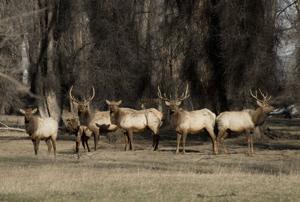Posted: Wednesday, July 8, 2015
Big game hunting outfitters who take clients afield in northern Jackson Hole each fall say they see no silver bullet to reversing a long-term decline in the migratory portion of the Jackson Elk Herd
But three outfitters contacted by the News&Guide all said they believed predators are playing a large role in the herd’s shift toward elk that migrate short distances onto summering grounds between Moose and Wilson.
Between
1978 and 2012 those short-distance migrants grew from less than 2
percent to 40 percent of the herd, according to new research headed by
National Elk Refuge biologist Eric Cole. In the same span, elk that
migrate to the Teton Wilderness and into southern Yellowstone National
Park declined from 40 to 11 percent of the herd.
Gros
Ventre Wilderness Outfitters’ Brian Taylor likened the shifting elk
herd dynamics to a person being mugged and learning to stay away from a
neighborhood. “If a guy goes down to the grocery store and the first
time he goes down there a thug beats the s--- out of him, the next time
he finds a better and safer place to buy his groceries,” Taylor said
Tuesday. “It doesn’t take long. Those elk are smart when it comes to
figuring out where there’s trouble.”
Despite
Taylor’s hunch that elk are learning to steer clear of predators,
Cole’s research, co-authored by U.S. Geological Survey ecologist Aaron
Foley, found that elk are not behaviorally “switching” away from
migration to the Teton Wilderness and Yellowstone.
Rather,
the scientists found, individual elk far in the backcountry are
successfully rearing half as many calves as suburban elk, and over time
the reproductive differences have favored one part of the herd over the
other.
Winter ranges ‘uninhabitable’
Harold
Turner, a partner in Triangle X Ranch and Teton Wilderness outfitter
since 1959, said his observations on the ground align with Cole’s
research, which will soon be published in the Journal of Wildlife
Management. “We
have noticed this now for the last 15, 20 years,” Turner said Tuesday.
“The wilderness elk, the Yellowstone elk and the forest elk have
plummeted, whereas the suburban elk have just exploded.”
Turner, like Taylor, thought predators were heavily implicated in the Jackson Elk Herd’s shifting dynamic. “Our winter ranges, because of the wolves, are absolutely uninhabitable now,” Turner said. “They don’t use them. We
went from about 900 head of elk in the late ’90s in the Buffalo Valley
and Spread Creek drainages,” he said. “This year we were down to 147.”
Yellowstone
Outfitters owner Lynn Madsen, who has guided for a quarter century out
of the Hawks Rest camp at the southeast corner of Yellowstone, also
pointed to wolves as a major factor in the elk herd’s shift. “I’ll
tell you one very simple thing, it’s called predation,” Madsen said.
“And now here we do not have any kind of a hunting season on the wolves,
and so the door’s open for them. “We’ve
all accepted the fact that we’re going to have wolves,” he said, “but
let’s manage them. Right now we’re not doing that with them taking our
hunting season away.”
Madsen
wants a heavier harvest of the Jackson elk that spend their entire year
not far from the National Elk Refuge in southern Jackson Hole. “To me it’s kind of a no-brainer,” he said. “No. 1, they need to reduce the local herd, the Teton Park herd. The
elk that are getting killed primarily are the migrational elk, both by
the hunters and by predation,” he said. “The urban herd, they’re having
60 calves plus per 100 cows.”
But
Madsen and the other outfitters didn’t blame the Wyoming Game and Fish
Department — which administers the hunt — for the steady growth of more
southerly suburban elk. Game and Fish’s hunt in the region, labeled area
78, begins mid-August, goes until the end of January and prioritizes
harvesting cows and calves.
‘Their hands are tied’
“I
think their hands are tied,” Madsen said. “You’re talking about a lot
of private grounds. Look at old Harrison Ford” — a valley landowner —
“He’s one of them that won’t allow hunting.”
Taylor also sympathized with the state wildlife agency. “The Game and Fish has a monumental task at hand in trying to manage the wildlife and deal with the backlash from the public,” he said.” It’s a big political thing to try to appease everybody and deal with hunting elk on these postage stamp” parcels of land.
Turner
said he feared Jackson Hole’s migratory elk were headed for steeper
declines, similar to those seen in moose in parts of the valley. But he
was also at a loss for a way to reverse the trend. “I
honestly don’t know the solution,” Turner said. “You can stop hunting
north of the refuge or north of the Buffalo Valley or north of the Gros
Ventre, and you’re going to save a few bulls because that’s all you can
hunt anyway.”
The
neighborhoods south of the park, he said, will never harbor predators
in dense-enough population to slow the elk population growth trend
there. “I
honestly don’t see at this point what they’re going to do about it,
because they can’t hunt the suburban elk just because of people’s
feelings,” Turner said. “They’re afraid somebody’s going to get shot,
and they don’t want blood and guts in their front yard, and I can’t say I
blame them.”
source



No comments:
Post a Comment